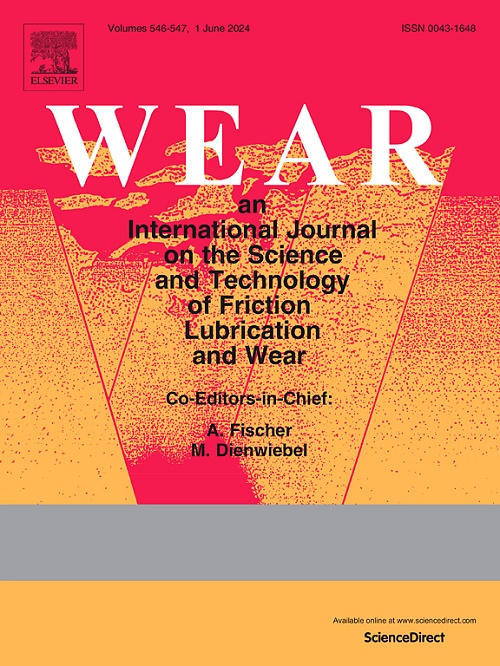hBN和石墨烯混合纳米流体的摩擦学性能对钻头磨损和孔表面质量的影响:WAAM和变形Inconel 625的对比研究
IF 5.3
1区 工程技术
Q1 ENGINEERING, MECHANICAL
引用次数: 0
摘要
加工因科乃尔合金由于其高强度、硬度和耐热性而面临相当大的挑战,这通常会导致更快的刀具磨损、较差的表面抛光、更高的切削温度和能源消耗。增材制造的Inconel 625加剧了这些挑战,因为其各向异性特性使加工变得更加困难。Inconel 625是一种广泛使用的镍基高温合金,在各种工业应用中发挥着关键作用,因此本研究的重点是钻取Inconel 625。钻井作业在航空航天制造等领域至关重要,在这些领域,精度、孔质量和效率至关重要。该研究旨在通过采用可持续纳米流体策略来提高线弧增材制造(WAAMed) Inconel 625的可加工性。合成了六方氮化硼(hBN)、石墨烯基单纳米流体和杂化纳米流体。此外,对纳米流体的体积比热容、润湿性和动态粘度进行了全面表征。混合纳米流体(hBN -石墨烯)具有优异的润滑和冷却性能。在干燥条件、hBN和石墨烯单纳米流体以及混合纳米流体辅助钻井条件下,对WAAM IN625和变形IN625的可切削性进行了评估,重点关注表面切削温度、表面粗糙度、孔圆度偏差、刀具磨损和形貌等指标。结果表明,与干式加工相比,混合纳米流体环境具有明显的优势,包括WAAM和锻造IN625的切削表面温度降低了37 - 41%,表面质量提高了41 - 45%,圆度偏差降低了53 - 54%。此外,刀具磨损最小化,减少了粘附和磨料磨损,从而大大延长了刀具寿命。本文章由计算机程序翻译,如有差异,请以英文原文为准。
Tribological performance of hBN and graphene-enriched hybrid nanofluids on tool wear and hole surface quality in drilling: A comparative study on WAAM and wrought Inconel 625
Machining Inconel alloys presents considerable challenges due to their high strength, hardness, and heat resistance, which often results in faster tool wear, poor surface polish, higher cutting temperature, and energy consumption. These challenges are exacerbated by additively manufactured Inconel 625, as its anisotropic properties make machining more difficult. This study focuses on drilling Inconel 625, a widely used nickel-based superalloy, owing to its critical role in various industrial applications. Drilling operations are essential in areas such as aerospace manufacturing, where precision, hole quality, and efficiency are of utmost importance. The study aims to enhance the machinability of wire-arc additively manufactured (WAAMed) Inconel 625 by employing sustainable nanofluids strategies. Hexagonal boron nitride (hBN), graphene-based mono nanofluids, and hybrid nanofluids were synthesised. Further, the nanofluids were thoroughly characterized for their volumetric specific heat capacity, wettability, and dynamic viscosity. A hybrid nanofluid with (hBN to graphene) exhibited excellent lubricating and cooling performance. The machinability of both WAAM IN625 and wrought IN625 was evaluated under dry conditions, hBN and graphene mono nanofluids, and hybrid nanofluid-assisted drilling, focusing on metrics such as surface cutting temperature, surface roughness, hole circularity deviation, and tool wear and morphology. Results demonstrated that the hybrid nanofluid environment offered substantial advantages over dry machining, including a 37–41 % reduction in cutting surface temperature, a 41–45 % improvement in surface quality and a 53–54 % decrease in circularity deviation for both WAAM and wrought IN625. Furthermore, tool wear was minimised, with less adhesion and abrasive wear, resulting in a much longer tool life.
求助全文
通过发布文献求助,成功后即可免费获取论文全文。
去求助
来源期刊

Wear
工程技术-材料科学:综合
CiteScore
8.80
自引率
8.00%
发文量
280
审稿时长
47 days
期刊介绍:
Wear journal is dedicated to the advancement of basic and applied knowledge concerning the nature of wear of materials. Broadly, topics of interest range from development of fundamental understanding of the mechanisms of wear to innovative solutions to practical engineering problems. Authors of experimental studies are expected to comment on the repeatability of the data, and whenever possible, conduct multiple measurements under similar testing conditions. Further, Wear embraces the highest standards of professional ethics, and the detection of matching content, either in written or graphical form, from other publications by the current authors or by others, may result in rejection.
 求助内容:
求助内容: 应助结果提醒方式:
应助结果提醒方式:


